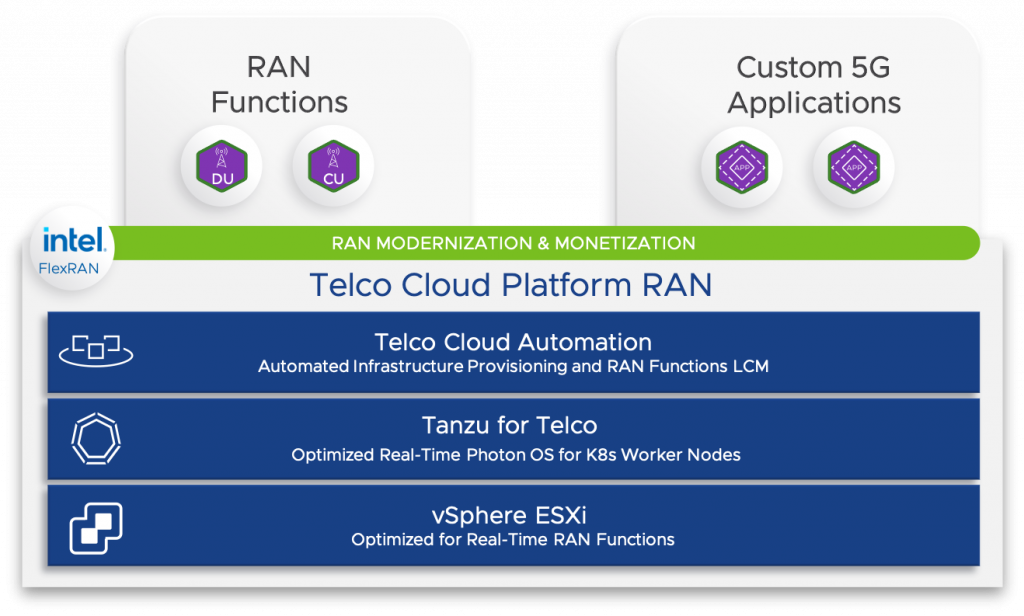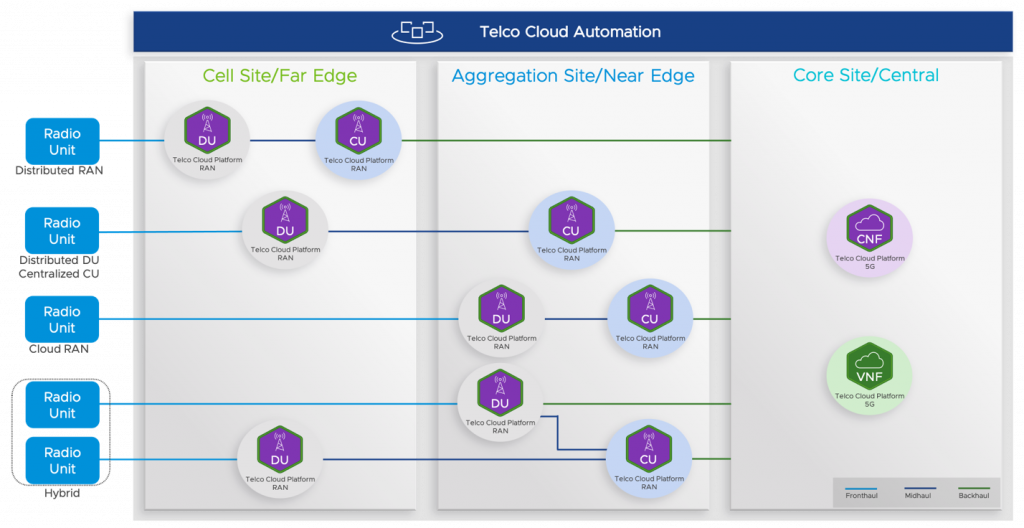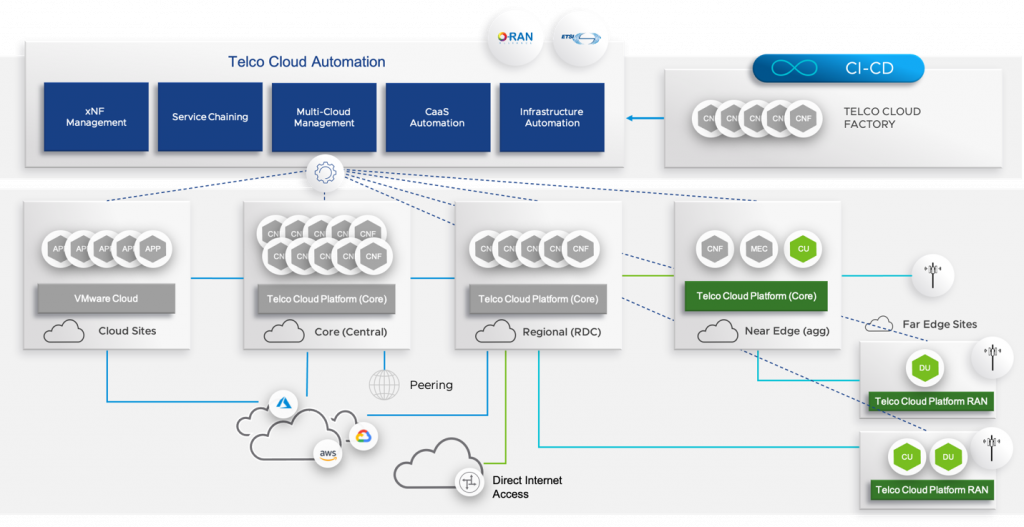The radio access network (RAN) is still being built with purpose-built hardware and software supplied by a few vendors. Although such monolithic stacks satisfy existing telecommunications requirements for the RAN, the reliance on purpose-built RAN systems leads to not only vendor lock-in but also inflexibility and inefficient silos.
- Inflexibility: A monolithic RAN stack lacks programmability, agility, rapid lifecycle management, and automation to meet the kind of bandwidth and latency demands that are essential with the shift to 5G services, edge computing, and all things cloud.
- Inefficiency: A traditional RAN system dedicated only to supporting RAN traffic creates a rigid and inefficient infrastructure silo, and causes an increased operational burden that is exacerbated with 5G distributed architectures
Virtualization and disaggregation start to solve these problems and set your network on a transformative course toward open RAN while empowering you to tap into the benefits of cloud-native technology, deploy and modify CNFs with speed and agility, and support innovative 5G services at the edge today. Virtualizing RAN functions and further disaggregating them by optimally placing them on a common and consistent horizontal platform radically improves flexibility and efficiency delivering an improved operational experience for service providers. It also streamlines access to and accelerates deployment of RAN functions from partners. In short, virtualizing the RAN brings the capabilities of the cloud to the edge and accelerates your transition to open RAN.
As CSPs introduce technologies to construct logical end-to-end networks tailored to different 5G services and to place applications on various clouds to deliver the best possible customer experience, RAN virtualization lets you efficiently host your choice of RAN functions with consistent operations regardless of location. With the agility, cloud capabilities, and programmability of RAN virtualization, such 5G use cases as cloud gaming, industrial IoT, and other low-latency edge computing move from a distant reality to near-instant actuality.
Introducing VMware Telco Cloud Platform RAN
VMware Telco Cloud Platform RAN enables CSPs to virtualize RAN functions on a platform optimized for the RAN using the Intel FlexRAN software reference design. VMware Telco Cloud Platform RAN is an extension of the VMware telco cloud, which is used by more than 120 CSPs to quickly deploy and efficiently operate virtualized network functions (VNFs) and containerized network functions (CNFs) with agility and scalability across 5G networks.
VMware Telco Cloud Platform RAN runs virtualized baseband functions, virtualized distributed units (vDUs), and virtualized central units (vCUs) in accordance with stringent RAN performance and latency requirements. VMware Telco Cloud Platform RAN meets or exceeds latency requirements for workload processing time on a DU, which has higher processing demands and more stringent latency requirements than CUs.
By combining the field-proven computing power of vSphere with VMware Telco Cloud Automation and a telco-grade Kubernetes distribution called Tanzu for Telco RAN, the platform puts RAN in the spotlight of modernization: The move to vRAN, with all its advantages, becomes an immediate reality, and the eventual evolution to open RAN becomes significantly closer.

By transforming the RAN now by moving from traditional RAN to virtualized RAN, you gain the future flexibility to evolve to open RAN later without having to disrupt your operations or overhaul your network design. And tapping the power of VMware’s partnerships and the platform’s automation makes it all happen faster still.
This modernization of the RAN yields immediate business benefits:
- Programmatically provision network functions across distributed vRAN sites wherever they are needed. This automated approach simplifies operations and let you quickly tailor and scale your 5G services to target markets to help create new revenue streams.
- Monetize 5G by quickly introducing new edge services while streamlining their management to keep costs down.
- Isolate vRAN functions in the virtualization layer and then apply consistent security policies to all your RAN sites to help protect functions and reduce the chance of configuration errors or other changes that can put them at risk. Security improves, and the risk associated with distributed cloud computing decreases.
RAN-Optimized Platform for Performance
Optimizations built into the platform contribute to flexibility by enabling you to dimension how many physical cores vSphere and Photon OS uses. On VMware Telco Cloud Platform RAN, Photon OS is the real-time Linux host of choice for DUs. Photon OS is a security-hardened minimalist Linux container host optimized for running containers on VMware vSphere. In addition, the strong isolation of running a container on a virtual machine on VMware ESXi adds a critical security layer of strong isolation. Networking is enhanced with Calico, Multus, DPDK, and SR-IOV.
Precision Time Protocol (PTP) accuracy, optional offloading of forward error correction (FEC), and acceleration to Intel Mount Bryce eASIC and N3000 FPGA round out the way the platform combines performance with flexibility. Performance validation with Intel’s FlexRAN reference design helps prove it all out.
A New Level of Flexibility
The platform takes flexibility to another level: You can deploy and operate non-RAN workloads on the same platform.
But it goes even further than that, because you can run different workloads with different Linux hosts or kernels — with the VMware hypervisor, ESXi, that’s used in VMware Telco Cloud Platform RAN, you can run the DU on a real-time Linux kernel without requiring that the CU also run on a real-time Linux kernel. By being able to run RAN and non-RAN workloads on the same platform at the edge and far edge, your radio access network turns into a multi-services 5G hub where — applications get direct access to the VMware Telco Cloud Platform RAN compute resources to deliver innovative 5G services from RAN sites.
This flexibility sets VMware Telco Cloud Platform RAN apart from other solutions. In this way, RAN modernization paves a path to 5G monetization at the edge.
What’s more: You get an open RAN future pass for eventually mixing CUs and DUs from different vendors.
Automation and Programmability
VMware Telco Cloud Platform RAN delivers the automation and programmability needed for a 5G future and the rise of edge computing.
Programmable resource provisioning optimizes where to locate CUs and DUs. When you onboard a vRAN function, you can programmatically adjust the underpinning platform availability and resource configuration based on the function’s requirements.

To meet high-performance, low-latency requirements, DUs can be placed at the far edge near users. At the same time, CUs, which might not need to meet the same high-performance, low-latency requirements as DUs, can be automatically placed or dynamically moved to be closer to the core to maximize resource utilization. These late binding capabilities of VMware Telco Cloud Automation let you dynamically move DU and CU resources on demand to improve resource utilization or to add more resources when necessary. If, for example, you need more resources for DU automation, you can move CU resources closer to the core.
VMware Telco Cloud Platform RAN is capable of provisioning over thousands of platforms across distributed RAN sites by gauging latency, bandwidth, and other requirements of each workload that will be instantiated.
- Here are some of the RAN automation capabilities the platform provides: Use templates to standardize site configurations and deployments across cell, aggregation, and central sites
- Automatically configure the virtual infrastructure
- Automatically discover, register, and create Kubernetes clusters from a centralized location

Automation and the Power of Partners
To maximize performance and improve resource utilization, VMware tests and integrates its RAN-optimized platform with key RAN vendors. In addition, VMware partners with industry-leading system integrators. Through the power of these partnerships, you gain the automation to deploy CNFs from key RAN vendors without having to do the heavy integration work — it’s already done for you.
The easy integration of functions from our partners benefits further from the automation that’s built into VMware Telco Cloud Platform RAN. As a result, the platform delivers simplicity and reliability while improving time to market for vRAN functions and 5G services.
This approach is also quite forward-looking. An open ecosystem with the flexibility to mix and match vendors coupled with the use of open APIs sets your RAN implementations on the course toward open RAN.

In addition, VMware Telco Cloud Platform RAN helps you integrate your development pipeline with your RAN deployments. A component of Tanzu for Telco RAN called Harbor can become a point of integration to connect your CI/CD pipeline with your RAN deployments. Harbor is a container image registry that scans container images for vulnerabilities, signs images as trusted, and secures them with role-based access control. Tanzu and Harbor can help your engineers speed up the development, testing, and deployment of CNFs and 5G services.
Laying the Groundwork for Open RAN
As its name implies, the concept of open RAN takes a traditionally closed network and opens it up. At a basic level, O-RAN means virtualizing and disaggregating the baseband unit (BBU) functions, separating the control plane from the data plane and opening up front-haul interfaces.
CSPs are looking to O-RAN as a way to re-structure how the RAN is organized and run, and future-proof it for long-term innovation. Open RAN will provide a strong foundation for CSPs to offer more innovative solutions to enterprise and consumer customers as well as partners within their broader ecosystem.
(For a step-by-step approach to moving in the direction of O-RAN, see our white paper titled O-RAN: Defining the Path for innovation in the RAN.)
Take Action to Move Forward
VMware Telco Cloud Platform RAN provides the efficiency, flexibility, and automation to secure a return on 5G investments and monetize the network by enabling new applications and services at the edge, which becomes a 5G multi-services hub. To find out more about VMware Telco Cloud Platform RAN, visit https://www.vmware.com/products/telco-cloud-platform-ran.html.
Discover more from VMware Telco Cloud Blog
Subscribe to get the latest posts sent to your email.









